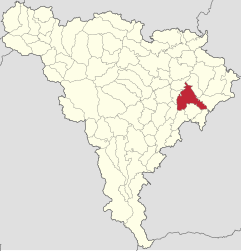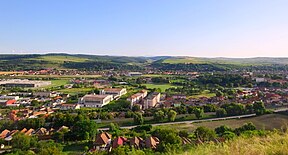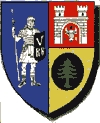Blaj
Blaj | |
|---|---|
 Location in Alba County | |
| Coordinates: 46°10′31″N 23°54′52″E / 46.17528°N 23.91444°E | |
| Country | Romania |
| County | Alba |
| Government | |
| • Mayor (2020–2024) | Gheorghe-Valentin Rotar[1] (PNL) |
Area | 98.93 km2 (38.20 sq mi) |
| Elevation | 260 m (850 ft) |
| Population (2021-12-01)[2] | 17,816 |
| • Density | 180/km2 (470/sq mi) |
| Time zone | EET/EEST (UTC+2/+3) |
| Postal code | 515400 |
| Area code | (+40) 02 58 |
| Vehicle reg. | AB |
| Website | www |
Blaj (Romanian pronunciation: [blaʒ]; archaically spelled as Blaș; Hungarian: Balázsfalva; German: Blasendorf; Transylvanian Saxon: Blußendref) is a city in Alba County, Transylvania, Romania. It has a population of 17,816 inhabitants (2021).
The city administers eight villages: Deleni-Obârșie (Obursatanya), Flitești, Izvoarele (until 1960 Ciufud; Csufud), Mănărade (Monora), Petrisat (Magyarpéterfalva), Spătac (Szászpatak), Tiur (Tűr), and Veza (Véza).
The city was the principal religious and cultural center of the Romanian Greek-Catholic Church in Transylvania.
History
[edit]Blaj is first mentioned in 1271 as Villa Herbordi, after the deed of a Count Herbod.[3][4] In 1313, the domain passed to Herbod's son Blasius Cserei and the town was mentioned as Blasii. Started as a hamlet for the twenty families of servants of the noble's court, it was awarded town status on May 19, 1737.
The first public school in Romanian was established in Blaj in 1754. Blaj was the first place to have Romanian written with Latin alphabet instead of Cyrillic in which it had traditionally been written. Blaj was also a center for the Romanian Age of Enlightenment, being the founding site of the Transylvanian School that promoted the Roman cultural heritage of the Romanians. Thus Blaj gained the nickname "The Little Rome",[5] as Romania's national poet Mihai Eminescu called it.
In 1848, Câmpia Libertății in Blaj was where over 40,000 Romanians met to protest Transylvania becoming a part of Hungary, holding that the lands would be stolen from them.[6]
Geography
[edit]Blaj lies at the confluence of the Târnava Mare and Târnava Mică rivers, where they form the Târnava River. It is located 39 km (24 mi) northeast of the county seat, Alba Iulia, in a renowned wine-growing region.
Demographics
[edit]| Year | Pop. | ±% |
|---|---|---|
| 1930 | 4,618 | — |
| 1948 | 6,641 | +43.8% |
| 1956 | 8,731 | +31.5% |
| 1966 | 15,775 | +80.7% |
| 1977 | 20,826 | +32.0% |
| 1992 | 22,425 | +7.7% |
| 2002 | 21,819 | −2.7% |
| 2011 | 20,630 | −5.4% |
| 2021 | 17,816 | −13.6% |
| Source: Census data | ||
At the 2021 census, Blaj had a population of 17,816.[7] At the 2011 census, the city had a population of 20,630, of which 16,779 (83.78%) were Romanians, 1,305 (6.51%) Hungarians, 1,850 (9.23%) Romani, and 45 (0.22%) Germans.
In terms of religious affiliation, 14,784 (71.19%) were Romanian Orthodox, 2,732 (13.24%) Greek-Catholic, 744 (3.58%) Roman Catholic, 985 Reformed Church, 408 Baptist, and 220 Pentecostal.
Education
[edit]The city has several high schools, including the Inochentie Micu Clain National College, the Ștefan Manciulea Technological High School, and the Sfântul Vasile cel Mare Greek-Catholic Theological High School.
Attractions
[edit]The castle of the Bethlen dynasty is a popular tourist site near Blaj. Other sights worth visiting include the Metropolitan Palace, the Holy Trinity Cathedral, the "Buna Vestire" Monastery, the Greeks' Church, the "Liberty Field", and Avram Iancu's oak.
Twin towns — Sister cities
[edit]Blaj is twinned with:
Natives
[edit]- Tiberiu Bărbulețiu (born 1963), politician
- Silviu Bindea (1912–1992), footballer
- Matei Boilă (1926–2015), politician, Greek-Catholic priest
- Bogdan Cistean (born 1986), footballer
- Sonia Colceru (born 1934), volleyball player
- Ferenc Csentery (1937–2014), abstract metal sculptor
- Doina Ivănescu (1935–1996), volleyball player
- Bogdan Jica (born 2000), footballer
- Nicolae Linca (1929–2008), welterweight boxer
- Daniel Lupașcu (born 1981), footballer
- Ioan Simu (1875–1948), Greek-Catholic priest and politician
- Ioan Suciu (1907–1953), bishop of the Greek-Catholic Church
- Daniel Tătar (born 1987), footballer
- Samuil Vulcan (1758–1839), bishop of the Greek-Catholic Church
Climate
[edit]Blaj has a humid continental climate (Cfb in the Köppen climate classification). The city has a continental temperate climate, characteristic for the Transylvanian Plateau, with moderate precipitations of around 550 mm/m2.
| Climate data for Blaj | |||||||||||||
|---|---|---|---|---|---|---|---|---|---|---|---|---|---|
| Month | Jan | Feb | Mar | Apr | May | Jun | Jul | Aug | Sep | Oct | Nov | Dec | Year |
| Mean daily maximum °C (°F) | 2.3 (36.1) |
5.1 (41.2) |
10.3 (50.5) |
16.2 (61.2) |
20.8 (69.4) |
24.1 (75.4) |
26.1 (79.0) |
26.3 (79.3) |
21.1 (70.0) |
15.5 (59.9) |
9.6 (49.3) |
3.5 (38.3) |
15.1 (59.1) |
| Daily mean °C (°F) | −1.6 (29.1) |
0.6 (33.1) |
5 (41) |
10.8 (51.4) |
15.7 (60.3) |
19.3 (66.7) |
21.2 (70.2) |
21.3 (70.3) |
16.2 (61.2) |
10.5 (50.9) |
5.1 (41.2) |
−0.1 (31.8) |
10.3 (50.6) |
| Mean daily minimum °C (°F) | −5 (23) |
−3.3 (26.1) |
0 (32) |
5 (41) |
10.1 (50.2) |
14 (57) |
15.9 (60.6) |
16.1 (61.0) |
11.5 (52.7) |
6.1 (43.0) |
1.6 (34.9) |
−3 (27) |
5.7 (42.4) |
| Average precipitation mm (inches) | 29 (1.1) |
27 (1.1) |
37 (1.5) |
56 (2.2) |
75 (3.0) |
84 (3.3) |
76 (3.0) |
56 (2.2) |
54 (2.1) |
43 (1.7) |
33 (1.3) |
36 (1.4) |
606 (23.9) |
| Source: https://en.climate-data.org/europe/romania/alba/blaj-44396/ | |||||||||||||
See also
[edit]References
[edit]- ^ "Results of the 2020 local elections". Central Electoral Bureau. Retrieved 6 June 2021.
- ^ "Populaţia rezidentă după grupa de vârstă, pe județe și municipii, orașe, comune, la 1 decembrie 2021" (XLS). National Institute of Statistics.
- ^ Mallows, Lucy; Abraham, Rudolf (26 November 2012). Transylvania. ISBN 9781841624198.
- ^ "Archiv des Vereins für Siebenbürgische Landeskunde". 1848.
- ^ "Blaj or "Little Rome", as Eminescu called it". AGERPRESS - the Romanian National News Agency. June 18, 2014. Archived from the original on July 9, 2018. Retrieved July 7, 2018.
- ^ Stoica, Vasile (1919). The Roumanian Question: The Roumanians and their Lands. Pittsburgh: Pittsburgh Printing Company. p. 23.
- ^ "Populația rezidentă după grupa de vârstă, pe județe și municipii, orașe, comune, la 1 decembrie 2021" (in Romanian). INSSE. 31 May 2023.







